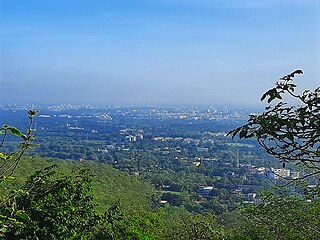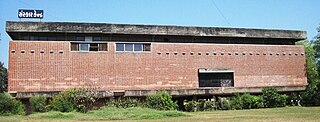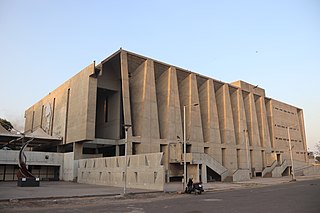
Gujarat is a state along the western coast of India. Its coastline of about 1,600 km (990 mi) is the longest in the country, most of which lies on the Kathiawar peninsula. Gujarat is the fifth-largest Indian state by area, covering some 196,024 km2 (75,685 sq mi); and the ninth-most populous state, with a population of 60.4 million. It is bordered by Rajasthan to the northeast, Dadra and Nagar Haveli and Daman and Diu to the south, Maharashtra to the southeast, Madhya Pradesh to the east, and the Arabian Sea and the Pakistani province of Sindh to the west. Gujarat's capital city is Gandhinagar, while its largest city is Ahmedabad. The Gujaratis are indigenous to the state and their language, Gujarati, is the state's official language.

Gandhinagar is the capital of the state of Gujarat in India. Gandhinagar is located approximately 23 km north of Ahmedabad, on the west central point of the Industrial corridor between Delhi, the political capital of India, and Mumbai, the financial capital of India.

Ahmedabad is the most populous city in the Indian state of Gujarat. It is the administrative headquarters of the Ahmedabad district and the seat of the Gujarat High Court. Ahmedabad's population of 5,570,585 makes it the fifth-most populous city in India, and the encompassing urban agglomeration population estimated at 6,357,693 is the seventh-most populous in India. Ahmedabad is located near the banks of the Sabarmati River, 25 km (16 mi) from the capital of Gujarat, Gandhinagar, also known as its twin city.
This page provides a historical timeline of Ahmedabad, the sixth largest city in India.

Godhra is a municipality in Panchmahal district in Indian state of Gujarat. It is the administrative headquarters of the Panchmahal district. Originally the name came from gou which means "cow" and dhara- which have two meanings depending on how you pronounce the word: 'dharaa' means a feminine thing or person that "holds" something and it usually means"land", and the other pronunciation is 'dhaaraa' in which means "flow". However, the second pronunciation is not popular nor is usually associated with this word. Hence, 'Godhra or Godharaa' means the Land of the Cow.
Kheda, also known as Kaira, is a city and a municipality in the Indian state of Gujarat. It was former administrative capital of Kheda district. India's First Deputy Prime Minister Vallabhbhai Patel Was Born In Kheda District of Gujarat State.Kheda city is famous for tobacco farming. The nearest railway station is Mahemadavad Kheda Road. Nearest Airport is Ahmedabad airport. Nearest Bus Station is "Kheda Bus Station".

Valsad, historically known as Bulsar, is a city and a municipality in Valsad district of the Indian state of Gujarat. It is the district headquarters of Valsad district. The city of Valsad is located in the south of Navsari and Surat.
Modasa is a town and a municipality in Aravalli district in the Indian state of Gujarat. Modasa was named after the Bhil chieftain Malaji Bhil, who ruled in Modasa during 1466.

Palanpur is a city and a municipality of Banaskantha district in the Indian state of Gujarat. Palanpur is the administrative headquarters of Banaskantha district. Palanpur is the ancestral home to an industry of Indian diamond merchants.

Balkrishna Vithaldas Doshi OAL was an Indian architect. He is an important figure in Indian architecture and noted for his contributions to the evolution of architectural discourse in India. Having worked under Le Corbusier and Louis Kahn, he was a pioneer of modernist and brutalist architecture in India.

Himatnagar or Himmatnagar is a municipality in Sabarkantha district in the Indian state of Gujarat. It is the administrative headquarters of the district. The city is on the bank of the river Hathmati.

Junagadh district is a district of the Indian state of Gujarat. Its administrative headquarters is the city of Junagadh.

Kasturbhai Lalbhai was an Indian industrialist and philanthropist. He co-founded the Arvind Mills along with his brothers and several other institutes. He was a cofounder of the Ahmadabad Education Society which initiated Ahmedabad University and the Indian Institute of Management Ahmedabad. He served as the chairman of historic and influential Anandji Kalyanji Trust that manages Shatrunjaya and several other Jain pilgrimage centers, for 50 years.

Sanskar Kendra is a museum at Ahmedabad, India, designed by the architect Le Corbusier. It is a city museum depicting history, art, culture and architecture of Ahmedabad. Another Patang Kite Museum is there which includes a collection of kites, photographs, and other artifacts. The campus is located at the west end of Sardar Bridge near Paldi.
Paldi is an area located in South Western Ahmedabad, India. Corporate offices and city centres of many national and international companies like ICICI Bank, Royal Bank of Scotland, Religare, Claris, Gujarat Gas are located within Paldi. It accommodates Sanskar Kendra museum by the renowned architect Le Corbusier as well as Tagore Memorial Hall. The National Institute of Design is located in Paldi. M K Gandhi's first ashram in India, Kochrab Ashram is also located in Paldi. This area has many houses of the Art Deco period.

Kalol is a city in Gandhinagar district in the Indian state of Gujarat, located alongside Gujarat State Highway 41 between the cities of Mehsana and Ahmedabad.
The Gujarati people or Gujaratis, are an Indo-Aryan ethnolinguistic group who reside in or can trace their ancestry or heritage to the present-day western Indian state of Gujarat. They primarily speak Gujarati, an Indo-Aryan language. While Gujaratis mainly inhabit Gujarat, they have a diaspora worldwide. Many notable independence activists were Gujarati, including Gandhi, Patel, and Jinnah.
Haku Vajubhai Shah was an Indian painter, Gandhian, cultural anthropologist and author on folk and tribal art and culture. His art belonged to the Baroda Group and his works are considered in the line of artists who brought themes of folk or tribal art to Indian art.
The Architecture of Gujarat consists of architecture in the Indian state of Gujarat.

Tagore Memorial Hall, also known as Tagore Hall, is an auditorium in Ahmedabad, India. It is designed by B. V. Doshi in 1961. It is an example of brutalist architecture. Construction started in 1966 and was completed in 1971. It was renovated in 2013.
















